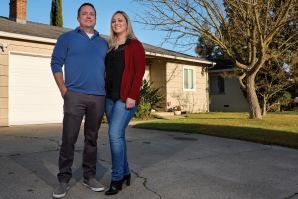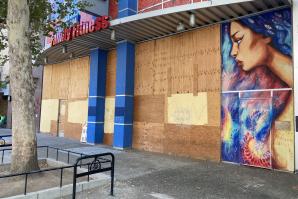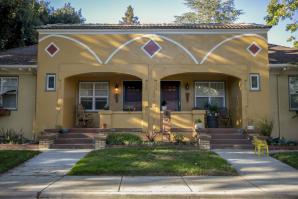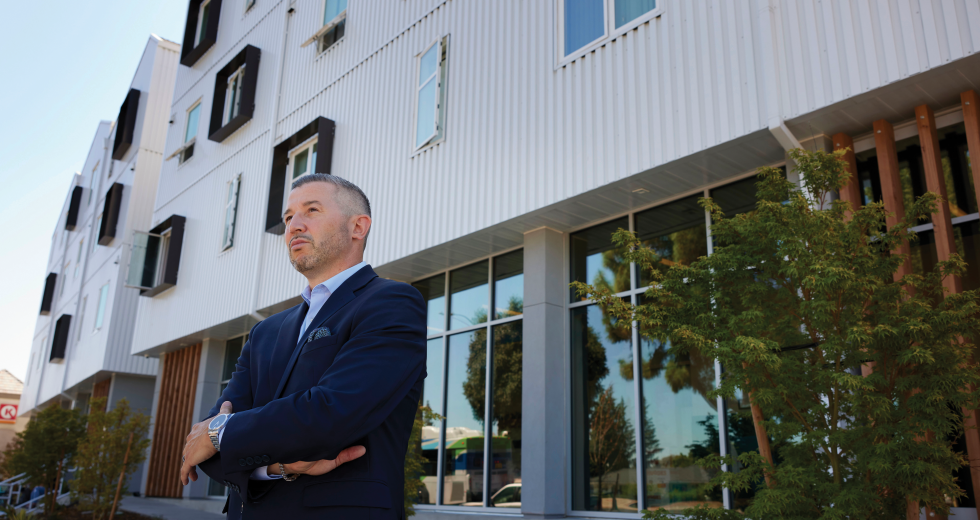Roseville perennially makes lists of best places to live, but for years the building at 130 Main Street was a weak link. Situated at a major entry to downtown and Old Town Roseville, it was a single-occupancy boarding house that was later vacated, condemned and often broken into. The city spent two decades struggling to revitalize the property: City Housing Manager Trisha Isom says it was the first project her husband Mike Isom took on when he joined the city’s planning department in 2000. (He’s now Roseville’s development services director.)
A breakthrough came in 2016 when affordable developer Meta Housing bought the parcel, with plans to construct a new affordable apartment complex. But putting together the capital would depend heavily on getting state tax credits that are the major source of funding for affordable housing projects. Those credits come in two flavors: 4 and 9 percent, and in the past a project was awarded either one or the other by a committee inside the State Treasurer’s Office.
But competition for both has been especially fierce in the last few years, and there weren’t enough of either to build the planned 65 units. Instead the city and the developer acquired a lot next to it and split the construction into two buildings, each qualifying for different credits. That generated enough to move forward — maybe the first time split financing was used for an affordable project in California, says Isom.
Both buildings were finished and started leasing in January 2021, part of a goal the city set in 1989 to have 10 percent of its housing stock be affordable. Roseville has more than 1,000 affordable units in the pipeline now, says Isom.
Making a dent in rising rents and home prices is one key to keeping businesses and people in the region and the state. All the Greater Sacramento region’s counties are behind on state-mandated goals for low-income housing construction, according to nonprofit California Housing Partnership, which defines the region as Sacramento County and five counties immediately surrounding it. Those trends mirror what’s happening statewide — counties are building less than a fifth of the number of affordable units needed to hit their targets.
The stakes are enormous. It’s not just that soaring housing costs affect the region’s economic growth, with employers shelling out money to give their workers a place to live and manufacturers looking elsewhere to site new facilities because of soaring rents and house prices. It’s also that jurisdictions that don’t hit their housing targets now risk real legal jeopardy. As part of a package of housing bills that Gov. Gavin Newsom signed last September, the state’s new Housing Accountability Unit will enforce each local government’s targets. The unit will bring escalating enforcement steps against jurisdictions out of compliance and can refer cases to the state attorney general for further action.
Getting affordable housing up takes ingenuity, teamwork and persistence — Roseville’s project had 17 funding sources. A few cities around the region have projects underway that showcase how they’re getting it done, and their success may hold lessons for other jurisdictions.
Better collaboration = Larger-scale projects and more housing
Roberto Jimenez is CEO at Sacramento-based nonprofit Mutual Housing California. For years he’d wanted to build an affordable community offering residents a spectrum of housing options, from rentals to single-family homes. Getting there would require a special parcel of land and a good partner. Mutual Housing had talked with Habitat for Humanity of Greater Sacramento — which helps low-income people buy their first homes — about the prospect. But they couldn’t find the land for it.
So when the Sacramento Housing and Redevelopment Agency announced it was donating a 7-acre parcel and seeking affordable developers, the two organizations jumped. Part of the property is zoned single-family, part multifamily. Habitat is building the single-family portion, putting up 18 homes, and Mutual Housing the apartments, 108 in all. Together, they’ll serve about 400 people. Called Cornerstone, it will be the first affordable mixed-housing project in Sacramento.
Getting these projects over the finish line requires great teamwork to assemble the puzzle pieces required to fund them, says Jimenez. SHRA donated the land and $10 million for the multiunit side of the project, plus 16 rental housing choice vouchers — federal help to pay rent also known as Section 8 — which were essential to ensure the steady cash flow that helped the project pencil out. Mutual Housing also relied heavily on state tax credits. Habitat, as it does with all of its homes, requires its buyers to contribute 500 hours of sweat equity and makes available 30-year zero-interest mortgages. The group raised money from corporate and individual donors and got about $1.7 million from Sacramento County, plus in-kind support from the Sacramento Municipal Utility District to make the homes all-electric and provide EV charging stations.
“I think if we could let down our guard a little bit and say, ‘This is what we do and let me learn a little bit about what you do — how can we work together to leverage that?’ we could do so much more.”
Leah Miller, CEO, Habitat for Humanity
Habitat CEO Leah Miller says the project is an example of what can happen when organizations stop worrying about territory. “I think if we could let down our guard a little bit and say, ‘This is what we do and let me learn a little bit about what you do — how can we work together to leverage that?’ we could do so much more,” she says.
Infill affordable: Harder to build but a bigger impact
It’s one thing to break ground on new land at the city’s edge and another to repurpose an empty lot downtown. The second is more complicated and expensive — and critically important to some jurisdictions’ goals of cutting homelessness while reducing commute times and sprawl, promoting sustainability, and spurring downtown development.
One of those jurisdictions is West Sacramento, and the building at 1801 West Capitol illustrates its goals. It’s the city’s first permanent supportive housing project, meaning it’s designed for people exiting homelessness. Built by nonprofit developer Mercy Housing California, its 85 units opened in December 2021.
In a permanent supportive model, tenants get not just a place to live but also help for issues that homelessness often worsens, like mental health treatment, independent living skills and employment. A 2020 UC San Francisco study found that the approach results in almost 90 percent of recipients leaving the streets permanently.
Funding for the West Capitol project came from every layer of government, says Aaron Laurel, city manager and port CEO. The city contributed the land. The county pitched in money from No Place Like Home, a state program funded at the county level. The state provided tax credits and bonds. And Sutter Health and Partnership HealthPlan of California pitched in $1 million each, part of an effort to cut down on emergency room visits by getting people into permanent homes.
Beyond funding, infill projects need help from local government to make them feasible for developers. In West Sacramento, that’s meant the city acquiring lots to create bigger parcels, cleaning up brown fields so developers don’t have to, and building centralized parking so they don’t need to build their own, says Laurel. Infill affordable projects may not have the dazzle of a new waterfront development — though West Sac has that too — but they’re an essential part of how the city wants to grow, he says.
Stockton’s downtown is in the middle of a transformation, too. Under a new economic plan in January 2022, city leaders are using money from the federal American Rescue Plan Act of 2021 to invest in improvements such as better lighting, treescapes and business facades, all in an effort to create a neighborhood feel downtown.
But a neighborhood needs people, and one part of that is Grand View Village, 75 units of workforce housing being built by affordable developer Visionary Home Builders on East Miner Avenue between North Hunter and North San Joaquin Streets.
What makes the project unique is its 10,000 square feet of commercial and community space on the ground floor, including a school and a critically needed grocery store, says Carrie Wright, the city’s director of economic development. Grand View is just part of the diversity of housing types the city wants downtown, says Wright — it’s also negotiating with developers on construction of 400 new units of workforce and market rate housing at a property called South Pointe on the far west side of downtown.
“It’s a lot easier to develop in green space than do infill development, but our general plan encourages infill, so Grand View fits that,” says Wright.
Lower-income seniors may be the most critical demographic
Older adults are the fastest-growing age group among California’s homeless population, according to national nonprofit Justice in Aging. In 1978 a group of Petaluma clergy and civic leaders, appalled to find elderly residents living in garages, storage units and tents, started the nonprofit affordable developer Petaluma Ecumenical Properties to tackle the problem.
Several years ago PEP, now based in Santa Rosa, saw a need for senior housing in Vacaville. The city “is in dire need of affordable housing, and seniors are the number one group,” says PEP Director of Development Jim Wallen. So the organization entered an agreement to buy a piece of city-owned property to construct a building with 59 one-bedroom apartments for older citizens.
PEP ran into multiple setbacks in building the fragile tower of capital needed to move forward with such projects. They applied for state tax credits but were turned down several times. That would have killed the effort had PEP not learned that the state had $563 million in leftover high-speed rail bonds that the state treasurer had converted to use for housing. PEP applied for and got the last tranche of that money, says PEP executive director Mary Stompe. And Vacaville provided loans plus 59 housing choice vouchers.
That wasn’t the end of it. FEMA’s flood maps required them to elevate the property, and they had to bring in 536 truckloads of dirt. The supply chain froze, and they paid an extra $300,000 for lumber after costs went up 240 percent. But the complex is slated for completion early next year.
Another city that needs senior housing is Folsom. One-bedroom apartments there were going for almost $2,400 a month in July, up about 25 percent since March 2019, according to rentcafe.com. So in January 2021 the city pitched in a $4.5 million loan for Sage at Folsom, a $32 million project for those ages 55 and older that’s slated to be finished in early 2023.
It’s in a prime market-rate location downtown, walking distance from health care providers, grocery stores, shopping centers and more. It will be powered by solar through a SMUD program, and it includes a community garden, health and wellness center, and a host of other amenities. Built by USA Properties Fund, a family of companies that specializes in affordable housing, the project will have rents priced between $450 and $1,300 for seniors with incomes between about $19,000 and $51,000.
Most project developers and city leaders agree on one idea: With state housing programs oversubscribed, cities usually have to kick in resources to make affordable housing projects go.
Cities also are trying to make developers’ jobs easier. Vacaville housing services director Emily Cantu says her city council has approved more construction of affordable housing in the last year than she’s seen in her 15-year career. And Isom says since 2015 Roseville’s housing division has had a housing analyst whose job is to liaise between housing developers and other city departments to smooth the road for their projects.
USA Properties Fund President Geoffrey Brown says he’s seeing the difference. “I think communities better appreciate the role of affordable housing now,” he says. “And I think they’re embracing it.”
–
Stay up to date on business in the Capital Region: Subscribe to the Comstock’s newsletter today.
Recommended For You

Chain Game
Capital Region residents and businesses feel the impact as construction industries continue to grapple with supply chain issues
Although the hot housing marketing has made it a great
time to be a builder in California, it’s also uniquely
challenging as supply chain issues create pricing
volatility, delays and decreased margins.

Home-Bidding Wars
There’s little sign the Capital Region’s spike in home prices will end anytime soon — what does it mean for business?
While the housing boom has led to issues like
limited affordable housing, some see the sizzling
market as a sign of the region’s dynamism. We evaluate how we got
here and what’s on the horizon.

The Next Act
Part 6 of our ongoing series on downtown Sacramento businesses dealing with COVID-19
Sacramento businesses continue to adapt and recalculate as COVID-19 evolves.

Duplex Housing Law Met With Fierce Resistance by California Cities
Cities around the state are trying to circumvent California’s new law allowing duplexes to be built on properties previously zoned as single family. Their methods include everything from removing parking and forbidding vehicle ownership to requiring arbitrary amounts of mature vegetation.

Shaking Up Real Estate
Tech firms aim to change the way we buy and sell homes — but take precaution
Opendoor and Amazon have entered the real estate market in Sacramento, and Zillow will expand here soon too, so it’s important to know how these companies work.

We Must Think Locally to End Homelessness
Homelessness is a societal tragedy, and in that sense it is like a fire, earthquake or flood. But it’s different, too. It’s a crisis that unfolds in slow motion.





Comments
AND, where is the sustainable water to come from?
It is heartening to see regional communities and local groups step up, in spite of the daunting complexity surrounding affordable housing. Kudos to West Sacramento, Folsom, Petaluma and others for the success stories. And where, pray tell, is the City of Sacramento in all this? Our commercial corridors are filled with squalid tent camps, spilling into our parks and neighborhoods. Yet after years of hand-wringing, false starts and excuses, there is precious little to show in the way of new housing for our poorest. Scandalous.